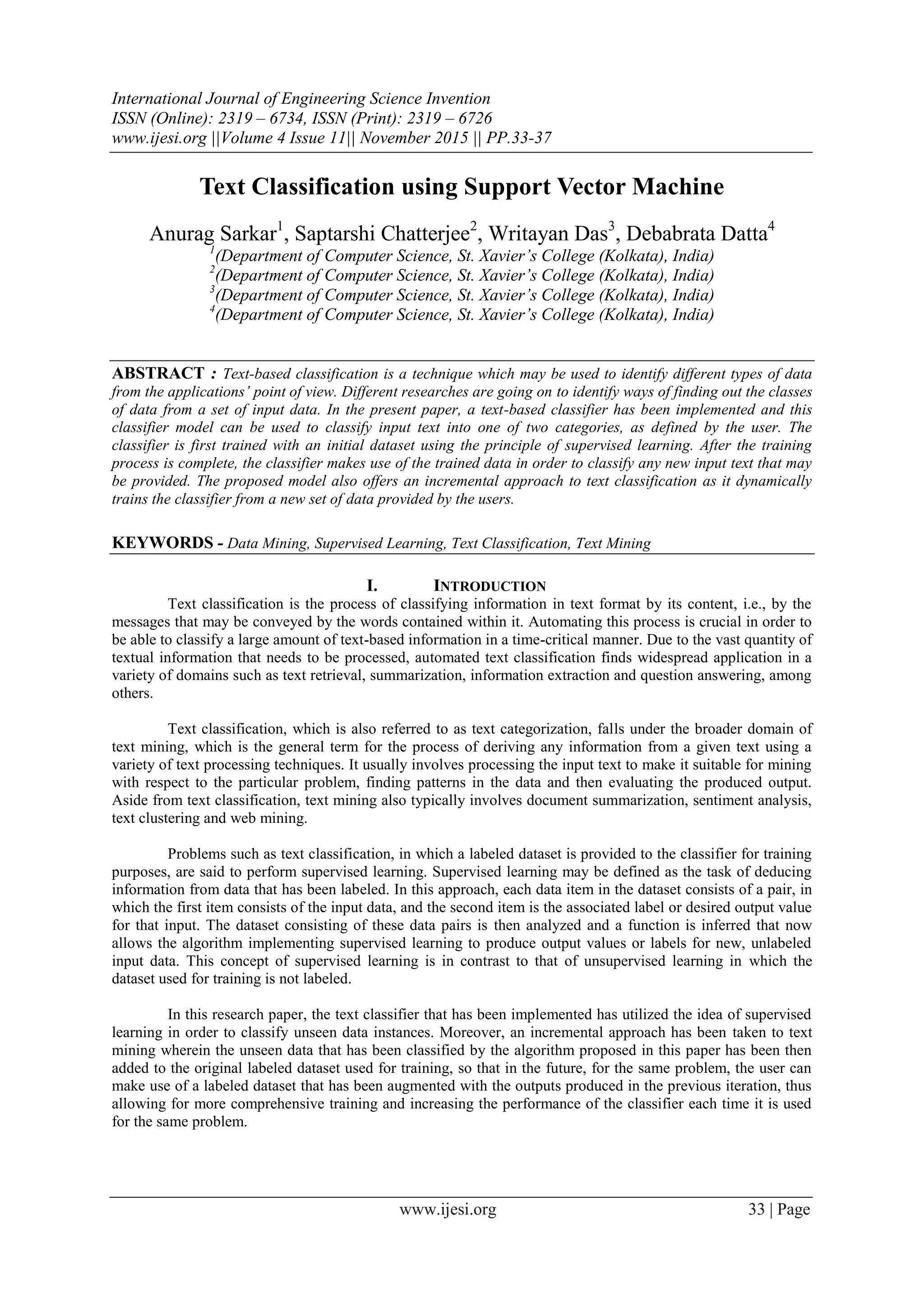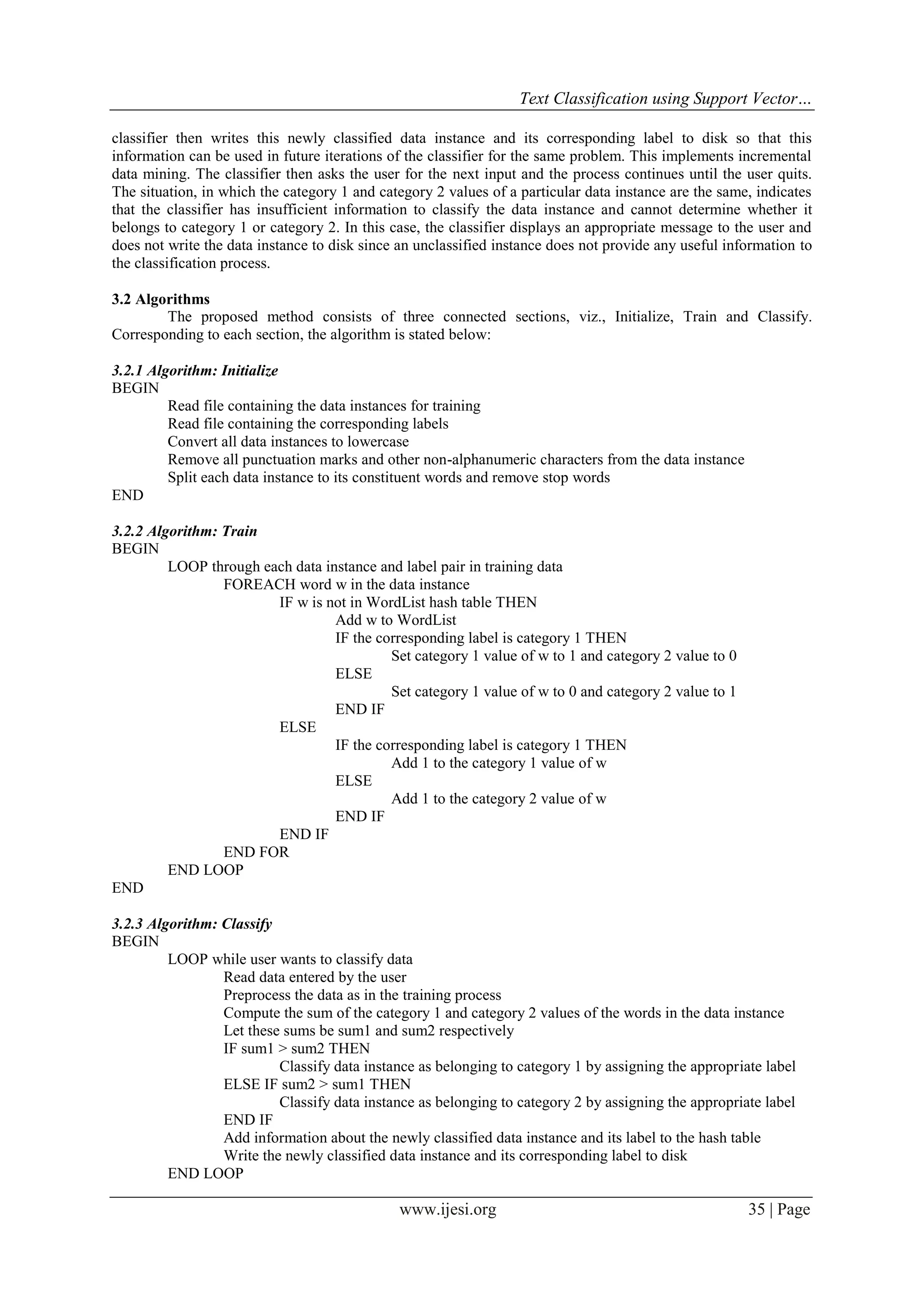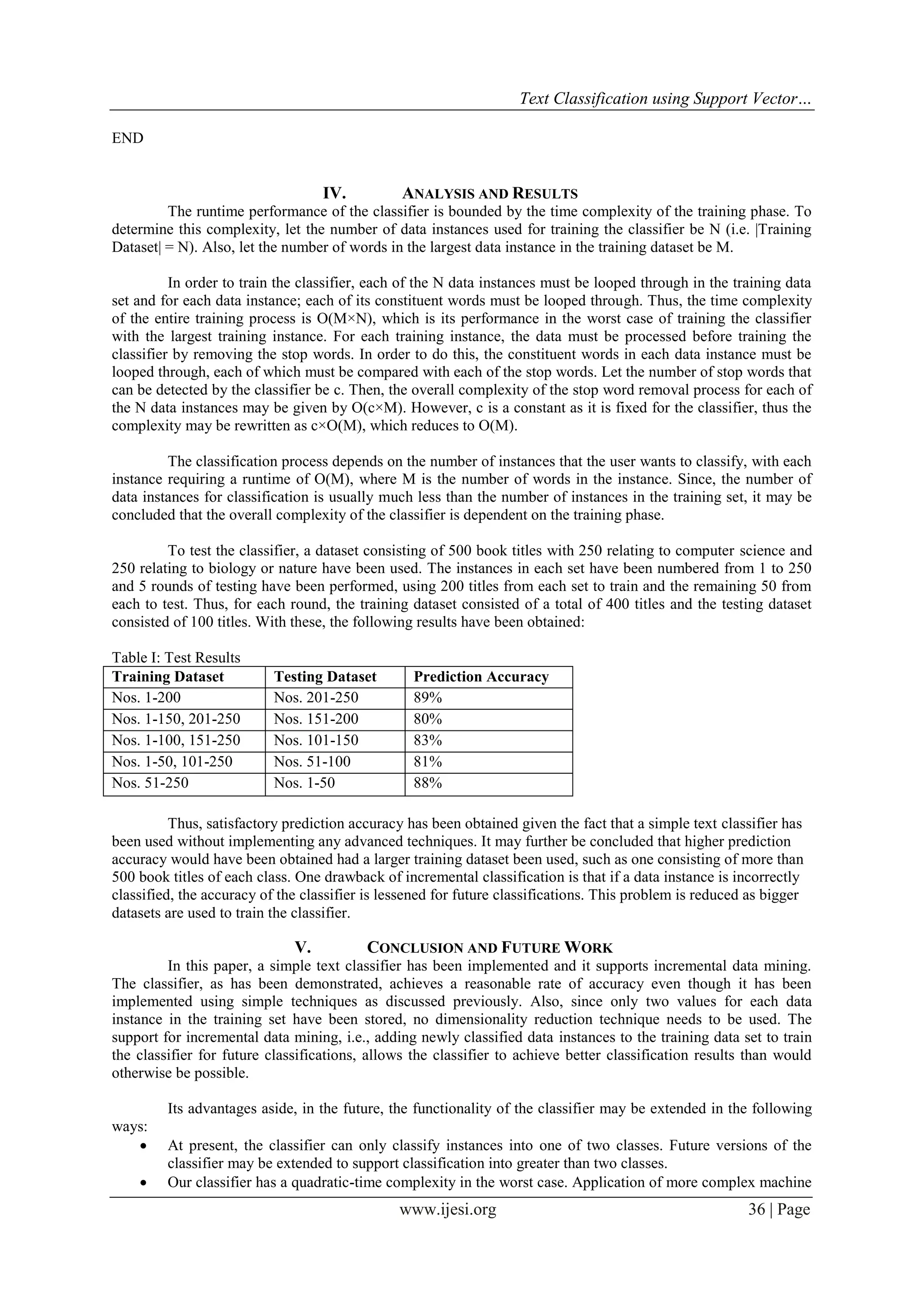The document presents a research paper on text classification using a Support Vector Machine (SVM) approach, developed by students from St. Xavier’s College, Kolkata. It details the methodology for training a text classifier with a focus on supervised learning and incremental data mining, facilitating the classification of text into user-defined categories. The paper discusses the classifier's performance, algorithms, and concludes with potential directions for future improvements in classification accuracy and complexity.

![Text Classification using Support Vector…
www.ijesi.org 34 | Page
The paper is structured as follows. Section 2 provides a brief overview of related work in the field of
text classification and cites a few examples of text classifiers implemented using various known techniques.
Section 3 contains a detailed description of the text classifier that has been proposed here. Section 4 includes a
discussion on the time complexity of the classifier and lists the results obtained upon using the classifier on a
dataset. Section 5 concludes the paper with a summary of the work and lists ways in which the classifier may be
improved in the future.
II. RELATED WORK
The paper in [2] had defined text categorization as “the task of automatically sorting a set of documents
into categories (or classes, or topics) from a predefined set” and had stated that it was in the domain of both
information retrieval and machine learning. As such, several techniques derived from these domains have found
application in implementing text classifiers. Joachims [3] had proposed the use of Support Vector Machines
(SVMs) for text classification and had also demonstrated that SVMs could offer better performance for text
classifiers as compared to other well known machine learning techniques such as Naïve-Bayes classifiers and k-
NN classifiers. Cristianini [4] had made a detailed discussion on the working of SVMs. A popular class of text
classifiers are the Naïve Bayes classifiers based on the Bayes’ theorem. In this regard, Leung had defined
Bayesian classifiers as statistical classifiers that can predict the probability of a particular sample belonging to a
particular class [5]. A variant of Naïve Bayes called Multinomial Naïve Bayes (MNB) is also often used in
solving text categorization problems as evidenced in the work by Frank and Bouckaert [6] who had proposed a
method that improves the efficiency of MNB classifiers used for text categorization by improving the
performance of MNB in the context of unbalanced datasets. Dai, Xue, Yang and Yu [7] had shown an
alternative way of Naïve-Bayes text classifier in which they had addressed the issue of classifying documents
across different distributions. The k Nearest Neighbors (k-NN) class of classifiers also finds wide use in text
classification problems. In the k-NN algorithm, for each data instance to be classified, its kth nearest neighbors
are determined to form the neighborhood of the instance. Then, majority voting within the neighborhood is used
to determine the class for the instance to be classified. In [8], Guo, Wang, Bell, Bi and Greer had developed a
new text classification process which combines the strengths of the k-NN classifier and another type of classifier
called the Rocchio classifier and had offered performance comparable to that of SVM-based text classifiers as
discussed above. Similarly, Toker and Kirmemis [9] had projected a simple implementation of the k-NN method
based text classifier which they use for developing a document organizing application. Li, Yu and Lu [10] had
introduced a modified k-NN method for text classification which had used a suitable number of the nearest
neighbors for prediction for different classes depending on the distribution of the class in the test documents.
III. PROPOSED METHOD
3.1 Methodology
The text classifier algorithm that has been implemented in the present research paper has utilized the
concepts of supervised learning and incremental data mining. To perform the classification, two files have been
taken as the inputs, the first containing the training data and the second containing the corresponding data labels.
The data from these two files has been used to train the classifier. A crucial aspect of designing a practical text
classifier is to reduce the dimensionality of features, which in this case are the different words in the training
data. To facilitate this, two key preprocessing steps have been performed. At first, all the words in the data have
been converted to the lower case since case sensitivity does not aid in the classification process and as the next
step, all the stop words have been removed from the training data. Stop words are the commonly occurring
words in the language that do not contribute any meaning that would benefit the text classification process. To
make the text classification process efficient, a hash table has been used and the keys of the hash table are the
words that appear in the training data and whose corresponding values constitute the information that will be
used to classify the text. The text classification process consists of two main stages – training and classification.
The training process involves loading the aforementioned hash table with the required information. In the hash
table, for each word (i.e. key) in the entire training dataset, two values have been stored – a category 1 value and
a category 2 value. The category 1 value is a count of the number of times that the word appears in a data
instance labeled as category 1. Similarly, the category 2 value is a count of the number of times that word
appears in a data instance labeled as category 2. The hash table thus acts as a training matrix consisting of data
used to train the classifier. Once the hash table has been loaded, the training process is complete. Now, the
classification process begins which makes use of the hash table, containing the trained data, to classify new data
instances provided by the user. The classification task is similar to the task of loading the hash table. The
classifier parses each data instance into its individual words and computes the category 1 and category 2 values,
as defined earlier, for each word. It then computes the category 1 and category 2 values of the data instance
itself by summing the category 1 and category 2 values of its constituent words. If the category 1 value of the
data instance is higher than the category 2 value, it is classified as a category 1 data instance and vice-versa. The](https://image.slidesharecdn.com/g411033037-151202103655-lva1-app6892/75/Text-Classification-using-Support-Vector-Machine-2-2048.jpg)


![Text Classification using Support Vector…
www.ijesi.org 37 | Page
learning and information retrieval techniques may help in achieving a better runtime complexity.
Higher prediction accuracy may be obtained by using more advanced weighting factors such as tf-idf
instead of simple frequency of occurrence as have been employed.
The classifier could also be improved by incorporating more advanced preprocessing techniques such
as word stemming.
REFERENCES
[1] M. Ikonomakis, S. Kotsiantis, V. Tampakas, Text Classification Using Machine Learning Techniques, WSEAS Transactions on
Computers, Issue 8, Vol. 4, August 2005, pp. 966-974.
[2] F. Sebastiani, Text Categorization, 2005: 683-687.
[3] T. Joachims, Text Categorization with Support Vector Machines: Learning with Many Relevant Features, Technical Report 23,
Universitat Dortmund, LS VIII, 1997.
[4] N. Cristianini, Support Vector and Kernel Machines, Tutorial at the 18th
International Conference on Machine Learning, June
28, 2001.
[5] K. Ming Leung, Naive Bayesian Classifier, Polytechnic University Department of Computer Science/Finance and Risk
Engineering, 2007.
[6] E. Frank, and R. R. Bouckaert, Naive bayes for text classification with unbalanced classes, Knowledge Discovery in Databases:
PKDD 2006, pp 503-510.
[7] W. Dai. et al., Transferring naive bayes classifiers for text classification, Proceedings of the national conference on artificial
intelligence, Vol. 22 No. 1, Menlo Park, CA; Cambridge, MA; London; AAAI Press; MIT Press; 1999, 2007.
[8] G. Guo et al., Using kNN model for automatic text categorization, Soft Computing 10.5, 2006: 423-430.
[9] G. Toker and O. Kirmemis, Text Categorization using k Nearest Neighbor Classification, Survey Paper, Middle East Technical
University.
[10] Baoli Li, Shiwen Yu, and Qin Lu., An improved k-nearest neighbor algorithm for text categorization, arXiv preprint cs/0306099,
2003.
[11] D. D. Lewis, and W. A. Gale, A sequential algorithm for training text classifiers, Proceedings of the 17th annual international
ACM SIGIR conference on Research and development in information retrieval, (Springer-Verlag New York, Inc., 1994).
[12] K. Nigam, A. McCallum, S. Thrun, and T. Mitchell, Learning to classify text from labeled and unlabeled
documents, AAAI/IAAI792, 1998.
[13] P. Soucy, G. Mineau, Feature Selection Strategies for Text Categorization, AI 2003, LNAI 2671, 2003, pp. 505-509.
[14] A. Kehagias, V. Petridis, V. Kaburlasos, P. Fragkou, A Comparison of Word- and Sense-Based Text Categorization Using
Several Classification Algorithms, JIIS, Volume 21, Issue 3, 2003, pp. 227-247.](https://image.slidesharecdn.com/g411033037-151202103655-lva1-app6892/75/Text-Classification-using-Support-Vector-Machine-5-2048.jpg)